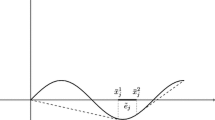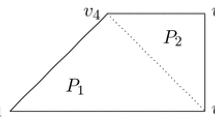Abstract
In this paper we discuss convex envelopes for bivariate functions, satisfying suitable assumptions, over polytopes. We first propose a technique to compute the value and a supporting hyperplane of the convex envelope over a general two-dimensional polytope through the solution of a three-dimensional convex subproblem with continuously differentiable constraint functions. Then, for quadratic functions as well as for some polynomial and rational ones, again satisfying suitable assumptions, we show how the same computations can be carried out through the solution of a single semidefinite problem.
Similar content being viewed by others
Notes
This can be checked in polynomial time (though cubic) with respect to the dimension of the matrix A.
References
Al-Khayyal, F.A., Falk, J.E.: Jointly constrained biconvex programming. Math. Oper. Res. 8, 273–286 (1983)
Anstreicher, K.M., Burer, S.: Computable representations for convex hulls of low-dimensional quadratic forms. Math. Program. B 124, 33–43 (2010)
Anstreicher, K.M.: On convex relaxations for quadratically constrained quadratic programming. Math. Program. B. Available at http://www.optimization-online.org/DB_HTML/2010/08/2699.html (2011, to appear)
Bao, X., Sahinidis, N.V., Tawarmalani, M.: Multiterm polyhedral relaxations for nonconvex, quadratically-constrained quadratic programs. Optim. Methods Softw. 24, 485–504 (2009)
Benson, H.P.: On the construction of convex and concave envelope formulas for bilinear and fractional functions on quadrilaterals. Comput. Optim. Appl. 27, 5–22 (2004)
Bomze, I.M., Duer, M., DeKlerk, E., Roos, C., Quist, A., Terlaky, T.: On copositive programming and standard quadratic optimization problems. J. Glob. Optim. 18, 301–320 (2000)
Brickman, L., Steinberg, L.: On nonnegative polynomials. Am. Math. Mon. 69, 218–221 (1962)
Choi, M.-D., Lam, T.-Y., Reznick, B.: Sums of squares of real polynomials. Proc. Symp. Pure Math. 58, 103–126 (1995)
Crama, Y.: Recognition problems for polynomials in 0–1 variables. Math. Program. 44, 139–155 (1989)
Crama, Y.: Concave extensions for nonlinear 0–1 maximization problems. Math. Program. 61, 53–60 (1993)
Diananda, P.H.: On non-negative forms in real variables some or all of which are non-negative. Proc. Camb. Philos. Soc. 58, 17–25 (1967)
Horst, R., Tuy, H.: Global Optimization: Deterministic Approaches, 3rd edn. Springer, Berlin (1996)
Kuno, T.: A branch-and-bound algorithm for maximizing the sum of several linear ratios. J. Glob. Optim. 22, 155–174 (2002)
Jach, M., Michaels, D., Weismantel, R.: The convex envelope of (\(n\)-1)-convex functions. SIAM J. Optim. 19(3), 1451–1466 (2008)
Jibetean, D., de Klerk, E.: Global optimization of rational functions: a semidefinite programming approach. Math. Program. 106, 93–109 (2006)
Khajavirad, A., Sahinidis, N.V.: Convex envelopes of products of convex and component-wise concave functions. J. Glob. Optim. Online first version available (2011, to appear)
Laraki, R., Lasserre, J.B.: Computing uniform convex approximations for convex envelopes and convex hulls. J. Convex Anal. 15, 635–654 (2008)
Liberti, L., Pantelides, C.C.: Convex envelopes of monomials of odd degree. J. Glob. Optim. 25(2), 157–168 (2003)
Linderoth, J.: A simplicial branch-and-bound algorithm for solving quadratically constrained quadratic programs. Math. Program. 103, 251–282 (2005)
Locatelli, M., Schoen, F.: On convex envelopes and underestimators for bivariate functions. Available at http://www.optimization-online.org/DB_FILE/2009/11/2462.pdf (2009)
Luedtke, J., Namazifar, M., Linderoth, J.T.: Some results on the strength of relaxations of multilinear functions. Technical report 1678. Computer Sciences Department, University of Wisconsin-Madison (2010)
McCormick, G.P.: Computability of global solutions to factorable nonconvex programs—part I—convex underestimating problems. Math. Program. 10, 147–175 (1976)
Meyer, C.A., Floudas, C.A.: Convex hull of trilinear monomials with mixed sign domains. J. Glob. Optim. 29, 125–155 (2004)
Meyer, C.A., Floudas, C.A.: Convex envelopes for edge-concave functions. Math. Program. 103, 207–224 (2005)
Nie, J., Demmel, J., Gu, M.: Global minimization of rational functions and the nearest GCDs. J. Glob. Optim. 40, 697–718 (2008)
Rikun, A.: A convex envelope formula for multilinear functions. J. Glob. Optim. 10, 425–437 (1997)
Rockafellar, R.T.: Convex Analysis. Princeton University Press, Princeton, NJ (1970)
Ryoo, H.S., Sahinidis, N.V.: Analysis of bounds for multilinear functions. J. Glob. Optim. 19, 403–424 (2001)
Sherali, H.D., Alameddine, A.: An explicit characterization of the convex envelope of a bivariate bilinear function over special polytopes. Ann. Oper. Res. 27, 197–210 (1992)
Sherali, H.D.: Convex envelopes of multilinear functions over a unit hypercube and over special discrete sets. Acta Mathematica Vietnamica 22, 245–270 (1997)
Tawarmalani, M., Sahinidis, N.V.: Semidefinite relaxations of fractional programs via novel convexification techniques. J. Glob. Optim. 20, 137–158 (2001)
Tawarmalani, M., Sahinidis, N.V.: A polyhedral branch-and-cut approach to global optimization. Math. Program. 103, 225–249 (2005)
Tardella, F.: On the existence of polyhedral convex envelopes. In: Floudas, C.A., Pardalos, P.M. (eds.) Frontiers in Global Optimization, pp. 563–574. Kluwer, Dordrecht (2003)
Tardella, F.: Existence and sum decomposition of vertex polyhedral convex envelopes. Optim. Lett. 2, 363–375 (2008)
Zamora, J.M., Grossmann, I.E.: A branch and contract algorithm for problems with concave univariate, bilinear and linear fractional terms. J. Glob. Optim. 14, 217–249 (1999)
Author information
Authors and Affiliations
Corresponding author
Appendix: Example 2.1
Appendix: Example 2.1
Since the computations are based on elementary (though tedious) computations, we only give a brief sketch about how to solve subproblem (9) without deriving the solutions for subproblems (10) and (11).
The general structure of the subproblems to be solved is the following
where \(\eta _j,\,j=1,\ldots ,r\), are either affine or concave functions, and \(S\) is some polyhedral region defined by the derivative conditions at the extremes of the convex edges. Then, in order to solve the subproblem, we can first split its feasible region into the following \(r\) subregions
next, we solve the problem over each subregion \(S_i\), which amounts at solving the following problem
Finally, we take the maximum of all the \(r\) optimal values. The procedure will now be illustrated with subproblem (9).
First, we make the change of variable
so that the subproblem can be rewritten as
Note that with respect to the general structure (23) we have
and
We will also use the following notation
The feasible region can now be split into the three sets \(S_i,\,i=1,\ldots ,3\), defined in (24).
Subregion \(S_1=\{\eta _2(a,z)\ge \eta _1(a,z),\ \eta _3(a,z)\ge \eta _1(a,z),\ z\in [1/4,1]\}\).
Note that
The optimal value over \(S_1\) is equal to
If \(x_0-2y_0-1\ge 0\) (i.e., over \(T^{\prime }_1\)), the optimal solution is \(a^*=0, z^*=\frac{1}{4}\) with optimal value \(-\frac{1}{2}y_0\). If \(x_0-2y_0-1\le 0\), then \(a^*=-\frac{1}{3}\left(\frac{1}{2}+2\sqrt{z}+2z\right)\), so that we are left with the following problem
The optimal solution is
with the optimal value
Subregion \(S_2=\{\eta _2(a,z)\le \eta _1(a,z),\ \eta _2(a,z)\le \eta _3(a,z),\ z\in [1/4,1]\}\).
It can be easily checked that over this subregion \(\eta _2(a,z)\ge \eta _1(a,z)\) implies \(a\ge 0\). In this case the optimal value is equal to
Therefore, the optimal solution is \(a^*=0, z^*=\frac{1}{4}\), with optimal value \(-\frac{1}{2} y_0\).
Subregion \(S_3=\{\eta _3(a,z)\le \eta _1(a,z),\ \eta _3(a,z)\le \eta _2(a,z)\ z\in [1/4,1]\}\).
We have
and we need to solve the problem
Therefore, \(a^*=-\frac{1}{3}\left(\frac{1}{2}+2 \sqrt{z}+2z\right)\) and we are left with the problem (26), whose optimal solution has been already obtained (to be more precise, we notice that the optimal solution is \(z^{*}=\frac{1}{4}\) also over \(T^{\prime }_1\)).
By combining the different optimal values, we can conclude that the optimal value for subproblem (9) is given by (12).
Rights and permissions
About this article
Cite this article
Locatelli, M., Schoen, F. On convex envelopes for bivariate functions over polytopes. Math. Program. 144, 65–91 (2014). https://doi.org/10.1007/s10107-012-0616-x
Received:
Accepted:
Published:
Issue Date:
DOI: https://doi.org/10.1007/s10107-012-0616-x




